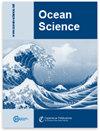Salt intrusion dynamics in a well-mixed sub-estuary connected to a partially to well-mixed main estuary
IF 4.1
3区 地球科学
Q2 METEOROLOGY & ATMOSPHERIC SCIENCES
引用次数: 0
Abstract
Abstract. Salt intrusion in estuaries has been exacerbated by climate change and human activities. Previous studies have primarily focused on salt intrusion in the mainstem of estuaries, whereas those in sub-estuaries (those that branch off their main estuaries) have received less attention. During an extended La Niña event from 2021 to 2022, a sub-estuary (the East River estuary) alongside the Pearl River estuary, China, experienced severe salt intrusions, posing a threat to the freshwater supply in the surrounding area. Observations revealed that maximum salinities in the main estuary typically preceded spring tides, exhibiting significant asymmetry in salinity rise and fall over a fortnightly timescale. In contrast, in the upstream region of the sub-estuary, the variation in salinity was in phase with that of the tidal range, and the rise and fall of the salinity were more symmetrical. Inspired by these observations, we employed idealized numerical models and analytical solutions to investigate the underlying physics behind these behaviors. It was discovered that under normal dry conditions (with a river discharge of 1500 m3 s−1 at the head of the main estuary), the river–tide interaction and change in horizontal dispersion accounted for the in-phase relationship between the salinity and tidal range in the upstream region of the sub-estuary. Under extremely dry conditions (i.e., a river discharge of 500 m3 s−1 at the head of the main estuary), salinity variations were in phase with those of the tidal range in the middle as well as the upstream region of the sub-estuary. The variation in salinity in the main estuary along with those in salt dispersion and freshwater influx inside the sub-estuary collectively influenced salinity variation in the well-mixed sub-estuary. These findings have important implications for water resource management and salt intrusion prevention in the catchment area.与部分混合到混合良好的主河口相连的混合良好的副河口的盐入侵动力学
摘要气候变化和人类活动加剧了河口的盐入侵。以往的研究主要集中于河口干流的盐入侵,而次河口(从主河口分支出来的河口)的盐入侵则较少受到关注。在 2021 年至 2022 年持续的拉尼娜现象期间,中国珠江口旁的一个子河口(东江河口)出现了严重的盐入侵,对周边地区的淡水供应构成了威胁。观测结果表明,主河口的最高盐度通常出现在春潮之前,在两周的时间尺度内,盐度的上升和下降表现出明显的不对称性。相比之下,在次河口的上游地区,盐度的变化与潮汐范围的变化相一致,盐度的涨落更加对称。受这些观测结果的启发,我们采用了理想化数值模型和分析方法来研究这些行为背后的基本物理现象。结果发现,在正常的干旱条件下(主河口河口的河流排放量为 1500 立方米/秒-1),河流与潮汐的相互作用以及水平扩散的变化是造成次河口上游地区盐度与潮差同相关系的原因。在极度干旱条件下(即主河口源头的河流排水量为 500 立方米/秒-1),次河口中游和上游地区的盐度变化与潮差变化同相。主河口盐度的变化以及次河口内部盐分扩散和淡水流入的变化共同影响着混合良好的次河口的盐度变化。这些发现对集水区的水资源管理和防止盐入侵具有重要意义。
本文章由计算机程序翻译,如有差异,请以英文原文为准。
求助全文
约1分钟内获得全文
求助全文
来源期刊

Ocean Science
地学-海洋学
CiteScore
5.90
自引率
6.20%
发文量
78
审稿时长
6-12 weeks
期刊介绍:
Ocean Science (OS) is a not-for-profit international open-access scientific journal dedicated to the publication and discussion of research articles, short communications, and review papers on all aspects of ocean science: experimental, theoretical, and laboratory. The primary objective is to publish a very high-quality scientific journal with free Internet-based access for researchers and other interested people throughout the world.
Electronic submission of articles is used to keep publication costs to a minimum. The costs will be covered by a moderate per-page charge paid by the authors. The peer-review process also makes use of the Internet. It includes an 8-week online discussion period with the original submitted manuscript and all comments. If accepted, the final revised paper will be published online.
Ocean Science covers the following fields: ocean physics (i.e. ocean structure, circulation, tides, and internal waves); ocean chemistry; biological oceanography; air–sea interactions; ocean models – physical, chemical, biological, and biochemical; coastal and shelf edge processes; paleooceanography.
 求助内容:
求助内容: 应助结果提醒方式:
应助结果提醒方式:


